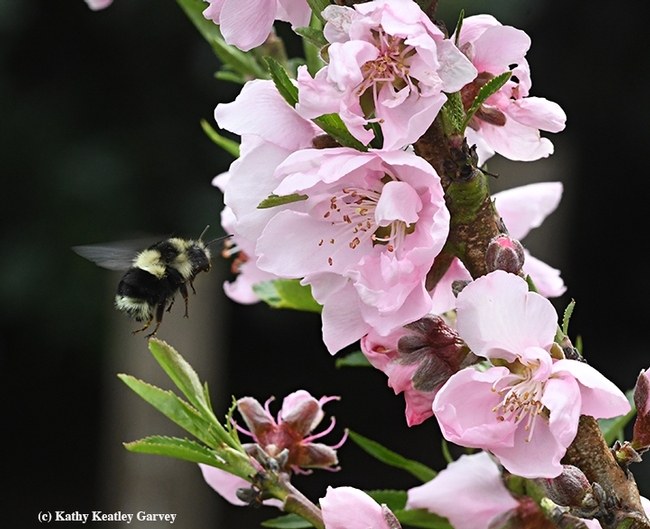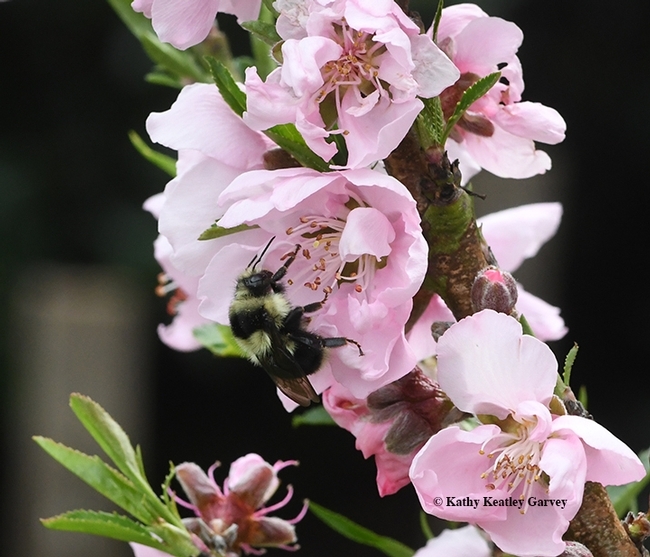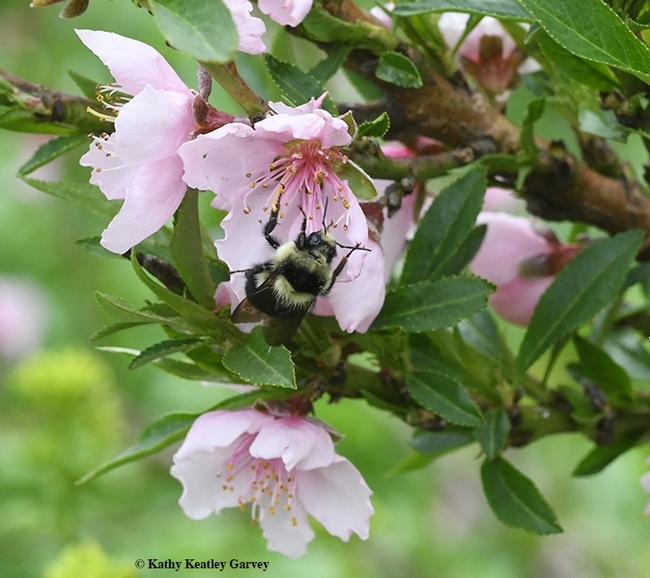Seen any bumble bees lately?
No? Me, neither.
It's almost the first day of spring, and bumble bees are as scarce as the proverbial hen's teeth. (Hens have no teeth, y'know.)
We've been watching our nectarine tree bloom. It's drawing honey bees, but no bumble bees.
Back on March 18, 2018, we spotted a number of bumble bees, including Bombus melanopygus, also known as the black-tailed bumble bee. This is one of the 27 species of bumble bees in California. We frequently see the yellow-faced bumble bee, Bombus vosnesenskii, and sometimes Bombus californicus, aka the California bumble bee.
Our March 18, 2018 "poster child" on our nectarine tree, Bombus melanopygus, appeared to be nesting nearby, due to her frequent visits.
National Public Radio reported on Feb. 6, 2020 that bumble bees are declining because of the extreme heat: "Extreme temperatures are driving a dramatic decline in bumble bees across North America and Europe, according to a new study, in yet another way climate change is putting ecosystems at risk.
"Researchers looked at half a million records showing where bumble bees have been found since 1901, across 66 different species. They found that in places where bumblebees have lived in North America, you're about half as likely to see one today. The decline is especially pronounced in Mexico, where bumble bees once lived in abundance."
Pesticides and habitat loss are also key factors. Says National Geographic in a Feb. 6, 2020 article titled Bumble Bees Are Going Extinct in a Time of 'Climate Chaos': "Climate change is not the only factor behind the insects' decline. They are also threatened by pesticides like neonicotinoids—which are extremely toxic to all bees—destruction of habitat by development and conversion of wildlands into agriculture, the spread of pathogens, and the release of non-native bees for commercial pollination."
If you're interested in learning more about bumble bees, check out the book, California Bees and Blooms: a Guide for Gardeners and Naturalists, the work of UC Davis and UC Berkeley scientists, including Robbin Thorp (1933-2019), distinguished emeritus professor of entomology at UC Davis, who also co-authored Bumble Bees of North America: an Identification Guide.
And if you see any bumble bees in your backyard in your yard between July 23 and Aug. 1, join the Third Annual Backyard Bumble Bee Count at https://www.inaturalist.org/projects/backyard-bumble-bee-count
As inaturalist.org says on its website: "Each bumble bee record submitted during the Backyard Bumble Bee Count helps researchers learn more about how bumble bees are doing and how to protect them and the environment we share. All observations collected July 23- August 1 will be included. For more information, including instructions, go to: https://backyardbbcount.wixsite.com/bumblebeecount."
Attached Images:

A black-tailed bumble bee, Bombus melanopygus, heading for the Garvey nectarine tree on March 18, 2018 in Vacaville, Calif. (Photo by Kathy Keatley Garvey)

Ahh, sweet nectar! A Bombus melanopygus nectaring on a nectarine blossom on March 18, 2018 in Vacaville, Calif. (Photo by Kathy Keatley Garvey)

Wait, just a little more! A Bombus melanopygus nectaring on a nectarine blossom on March 18, 2018 in Vacaville, Calif. (Photo by Kathy Keatley Garvey)